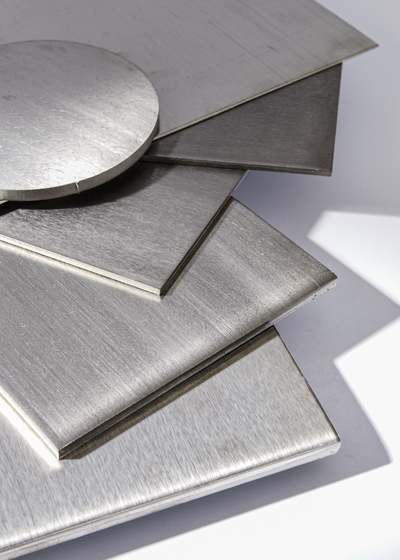High-purity nickel for the production of electroplated diamond and CBN tools
Anodes made of conventional nickel designated Ni 99.2 (2.4066) and Ni 99.6 (2.4060) tend to passivate during electrolytic dissolution.
To improve the dissolution behavior of these anodes, either additives for depassivation (e.g. chlorides) must be added to the bath or sulfur must be added to the anodes for depolarization. Both are associated with disadvantages. Chloride additives have an embrittling effect on the deposited nickel layers and are also relevant in terms of occupational safety and environmental protection.
When using sulfur-depolarized nickel, there is a risk of sulfur accumulation in the electrolyte. It is generally known that insoluble NiS compounds are formed during dissolution of the anodes and precipitated as anode slimes. However, especially with longer bath lifetimes, carryover of dissolved sulfur to the cathode and its incorporation into the deposited nickel layer cannot be ruled out.
This results in embrittlement of the coating. Particularly at elevated operating temperatures, segregation of the sulfur along the grain boundaries can lead to further loss of ductility in the nickel layer. In addition, sludge formation, even when anode bags are used, generally shortens the service life of the bath and leads to nickel losses. This is because the nickel bound in the sludge is no longer available for the deposition process at the cathode.
With High Purity Nickel HPN™, Hpulcas GmbH has developed a special high-purity nickel which, on the one hand, does not passivate and, on the other hand, reduces the entry of impurities into the electrolysis process to a minimum.
High Purity Nickel HPNTM has a purity of Ni 99.995%. It is manufactured using a patented process and is neither molten nor powder metallurgy. It is characterized by an extremely low sulfur content, which is between 0.1 and 0.5ppm depending on the batch.
Industries and applications
Ultra-pure nickel HPN™ anodes are used for:
- Nickel bonding in abrasive coatings with carbide or diamond particles for grinding and cutting tools, especially electroplated diamond grinding wheels.
- The electrolytic coating of surfaces
- Electroforming of parts and components
Properties and advantages of Hpulcas™ HPN™
- High purity nickel, non-passivating
- HPN™ anodes exhibit uniform dissolution behavior with low pitting tendency
- HPN™ anodes dissolve completely without sludge formation
- Due to the extremely high purity, no foreign elements are introduced via the anode material into the
electrolysis process via the anode material - Increased bath service life with economic and ecological advantages
- HPN™ electrolytic layers are characterized by excellent properties (e.g. high ductility)
and lower residual stresses in the layers. These are important in selected electroplating applications
(e.g. embedding of abrasive particles, electroforming, etc.) of considerable advantage. - Particularly good and adhesive bonding of abrasive grains or hard particles is achieved.
- High-purity HPN™ nickel anodes are supplied by Hpulcas GmbH to customer specifications in various forms
(sheet blanks, rounds, bars, wire grain or pellets). - Sheet metal anodes up to the size 600mm x 2,000mm with a max. thickness of 10mm,
also as blanks as well as small lot sizes are available.
![[Translate to English:] InDiamond.world](/fileadmin/_processed_/a/1/csm_InDiamond_Logo_2021_1fb017de30.png)
